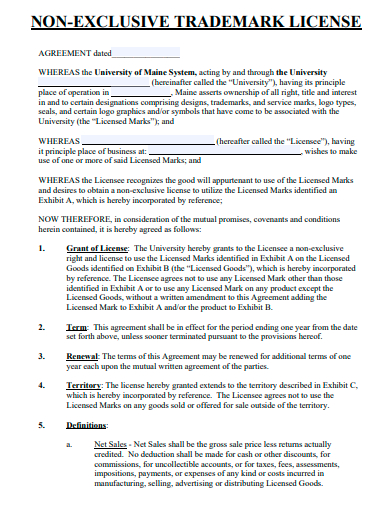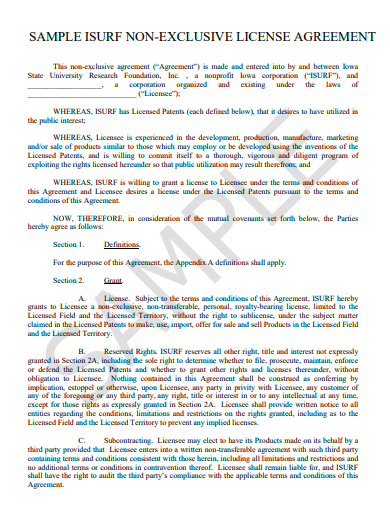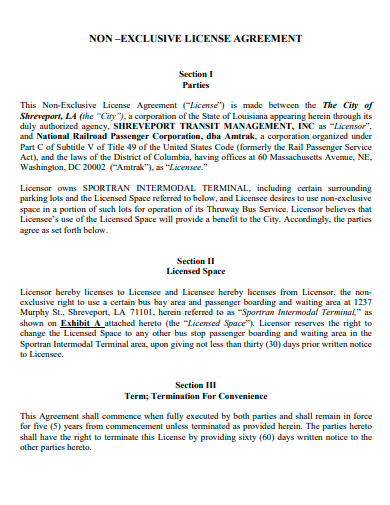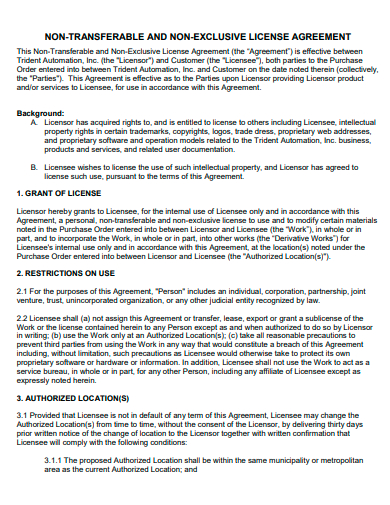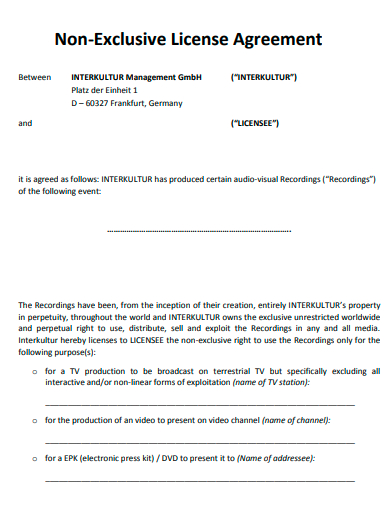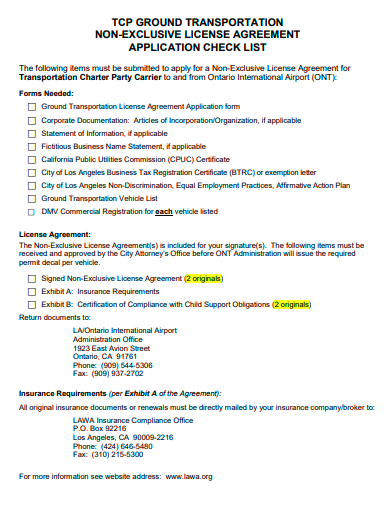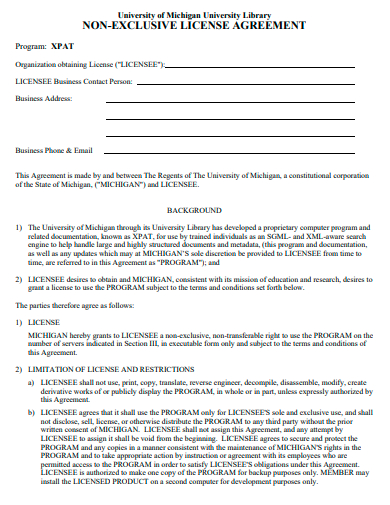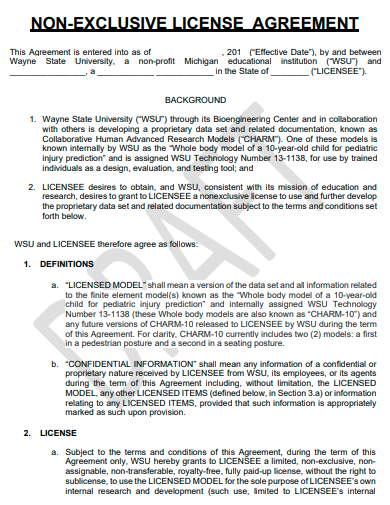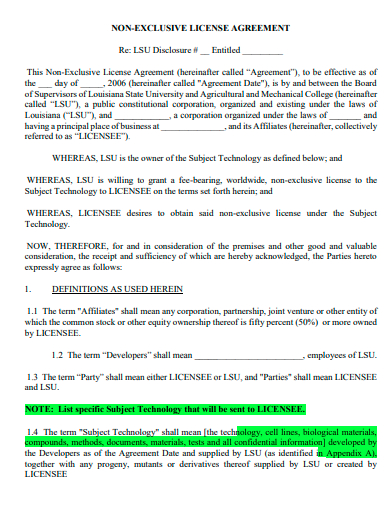Arranging your intellectual property licensing is an important factor you have to consider when making decisions for your business or company. One of the many questions you have to respond to during a licensing agreement is whether you want it to be exclusive or non-exclusive. You have to determine and consider each category and element’s pros and cons. The decision you will come up with will match the nature of your intellectual personality, as well as your marketing plan or marketing strategy and your ability in business management.
FREE 10+ Non-Exclusive License Agreement Samples
1. Non-Exclusive Trademark License Agreement
2. Non-Exclusive Copyright License Agreement
3. Sample Non-Exclusive License Agreement
4. Non-Exclusive Software License Agreement
5. Non-Exclusive License Agreement Example
6. Non-Transferable and Non-Exclusive License Agreement
7. Non-Exclusive License Agreement in PDF
8. Non-Exclusive License Agreement Application Checklist
9. Basic Non-Exclusive License Agreement
10. Draft Non-Exclusive License Agreement
11. Printable Non-Exclusive License Agreement
What is a Non-Exclusive License Agreement?
A non-exclusive license agreement is a formal and legal document that involves two parties in which one party or licensee agrees or permits the other party or the licensor to use their trade secrets or intellectual property. This right is generally valid for a given period of time and can be terminated at a specified time by either party with reasonable notice. However, a licensee can establish a middle-ground between an exclusive and non-exclusive license agreement which is called ‘co-exclusive’.
How to Write a Non-Exclusive License Agreement?
Non-exclusive licenses are used to grant the licensee rights to intellectual property as well as enable the licensor rights to utilize the intellectual property such as by granting more licenses to other organizations. This agreement provides more advantages for the licensor in the long term because it helps in increasing the number of granted licenses which enables the licensor to keep their rights to developing and utilizing its own intellectual property.
Step 1: Provide the Definitions of the Terms
A non-exclusive license agreement has a section for the definition of terms used in the document such as Affiliates, Calendar Quarter, Calendar Year, Change of Control, Combination Product, Confidential Information, Control or Controlled, Diagnostic Application, Field, GAAP, Improvement Patents, and more.
Step 2: Include the Grant of License
The grant of license contains information on the granting of licenses to a licensee and their affiliates. It also includes the rights granted as well as the rights that were not granted. This section also includes information on the Option to Improvement Patents and the No Implied Licenses.
Step 3: Write the Description of the Intellectual Property
In this section, the Filing, Prosecution, and Maintenance of Licensed Patents are located. It explains the ability of the licensor to have the right to prepare, file, maintain, and prosecute all of the licensed patents.
Step 4: Describe the Representation and Warranties of the Agreement
In this part of the non-exclusive license agreement, you will describe the representation and warranties of each party, the disclaimer, representation by legal counsel, and indemnity.
FAQs
What are the common sections in a non-exclusive license agreement?
The common sections you can find in a non-exclusive agreement are the definitions, grant of a license, consideration, intellectual property, confidentiality, representations and warranties, term and termination, release, and miscellaneous.
What is the difference between an exclusive and non-exclusive license agreement?
An exclusive license allows you to grant the rights to use a part of your intellectual property in a specified method to a partner and forbids other users from utilizing the same property on a certain period of time while the non-exclusive license also grants the same right but you can grant a non-exclusive license to more users at the same time.
What are the benefits of using non-exclusive license agreements?
Non-exclusive license agreements go well for intellectual property that can be utilized by many partners and does not require serious investment in the market. It is also beneficial to use products made from licensed intellectual property, giving them a head start from other competition.
A non-exclusive license agreement is an agreement contract that does not include exclusive rights that prevent either party from establishing a profitable relationship with other companies or businesses. A non-exclusive license agreement provides the same right as given in an exclusive license agreement but you can choose to grant a number of non-exclusive licenses to other users at the same time.
Related Posts
FREE 10+ Trial Agreement Samples In MS Word | Google Docs | Apple Pages | PDF
FREE 9+ Shop Rental Agreement Samples [ Commercial, Lease, Tenancy ]
FREE 10+ Charter Agreement Samples In MS Word | Google Docs | Apple Pages | PDF
FREE 10+ Mentoring Agreement Samples In MS Word | Apple Pages | PDF
FREE 10+ Partner Agreement Samples In MS Word | Google Docs | Apple Pages | PDF
FREE 10+ Individual Agreement Samples In MS Word | Google Docs | Apple Pages | PDF
FREE 10+ Strategic Agreement Samples In MS Word | Google Docs | Apple Pages | PDF
FREE 10+ Equity Agreement Samples In MS Word | Google Docs | Apple Pages | PDF
FREE 10+ Producer Agreement Samples in MS Word | Apple Pages | PDF
FREE 10+ Grant Agreement Samples In MS Word | Apple Pages | PDF
FREE 8+ Meeting Agreement Samples in MS Word | Google Docs | Apple Pages | PDF
FREE 10+ Community Agreement Samples In MS Word | Google Docs | PDF
FREE 8+ Real Estate Option Agreement Samples in MS Word | PDF
FREE 10+ Call Option Agreement Samples In MS Word | PDF
FREE 10+ Advertising Agreement Samples In MS Word | Google Docs | Apple Pages | PDF

